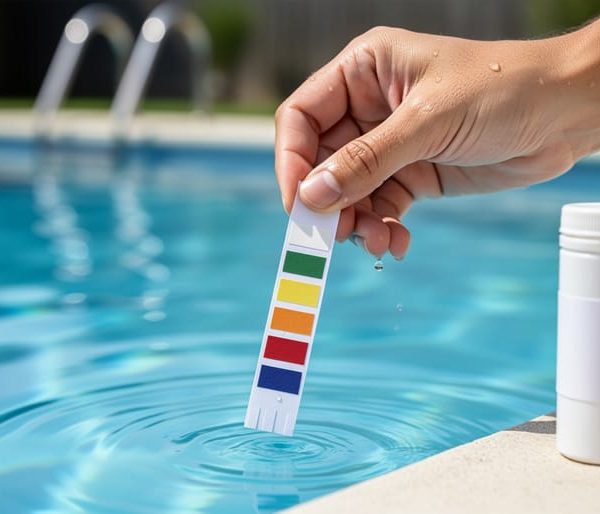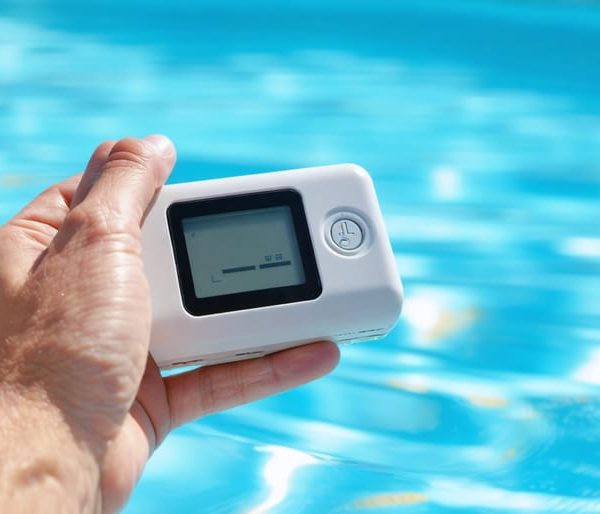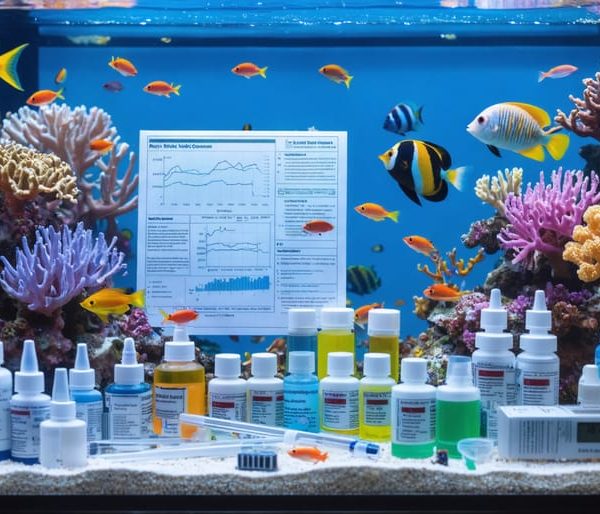An aquarium test kit is a must-have for every aquarium and fish tank owner to monitor and accurately read the state of the freshwater tank, pond, or salt-water tank. Without aquarium water testing kits, you’ll be in the dark about the state of your aquarium, and your fish may suffer.
In this review, you will find the best aquarium test kit for your needs.
Best Aquarium Test Kits at a Glance
- Best Overall – API Freshwater Master Test Kit
- Runner Up – Tetra EasyStrips Complete Aquarium Test Kit
- Extended Longevity – BOSIKE Aquarium 6-in-1 Test Strips
- Best for Beginners – Aqua Care Pro Freshwater Aquarium Test Kit
- Easy Ammonia Testing – API Ammonia Test Kit
- Trace Heavy Metals – Life2O Ultimate 14-in-1 Water Testing Kit
- Best Value – API 5-in-1 Test Strips
- Runner Up Saltwater Testing – Qguai 9-in-1 Aquarium Test Kit
- With Thermometer – SJ Wave 6-in-1 Test Kit
- Best for Saltwater Testing – JNW Direct 9-in-1 Aquarium Test Kit
Review Summary
Though all the aquarium test kits are solid choices, certain test kits have the edge over others in certain areas.
- In terms of durability (shelf life), we recommend the Qguai, API Freshwater Master Test Kit, and BOSIKE test kits.
- We recommend the Life2O Ultimate and BOSIKE test kits in terms of versatility.
- For range, we recommend Life2O Ultimate, the API Freshwater test kit, and JNW Direct.
- We recommend API and the Tetra EasyStrips for affordability.
10 Best Aquarium Test Kits Reviews
1. API Freshwater Master Kit
API Freshwater Master Test Kit is best for those who want to test the five most important water parameters.
This is unarguably one of the best and most reliable freshwater aquarium test kits on the market. API liquid test kits are foolproof, and their testing process is straightforward.
It bases its usage on the use of colors for enhanced simplicity. In addition, the test kit comes with drip-style reagent bottles, which is vital for getting very precise readings.
This test kit includes a color chart to compare with the color of your testing solution. It delivers the test results within a few minutes. However, the best thing about this test kit is that it’s very durable. It can serve you for up to 800 tests in your freshwater aquariums.
Pros and Cons
2. Tetra EasyStrips Complete Aquarium Kit
Tetra EasyStrips Complete Aquarium Kit is best for those who specifically want to test for ammonia levels in their freshwater or saltwater aquarium.
Of course, its ability doesn’t stop there; it also extends to testing other water parameters such as chlorine, hardness, pH, nitrite, and nitrate. As a result, this kit is more versatile than API Freshwater Master Test Kits, that test for only five parameters.
The six parameters mentioned above can be tested using a single 6-in-1 strip. All you have to do is dip the strips into the water for a minimum of 60 seconds. Then, take it out and make a color comparison with the color chart.
This test strip is buyers’ favorite because of its unique design. Unlike other test kits, it doesn’t stack several testing pads on top of each other.
Pros and Cons
3. BOSIKE Aquarium 6-in-1 Test Strips
BOSIKE Aquarium 6-in-1 Test Strips are best for those who want to test a variety of water bodies such as standard tropical freshwater tanks, shrimp tanks, fish tanks, ponds, Betta tanks, etc. It’s also ideal for those who want to test for carbonate hardness and general hardness, among other testing parameters.
This liquid test kit utilizes strip-style testing. Its strips come with six panels for testing distinct parameters. Like Tetra EasyStrips, these six panels have sufficient space between them to prevent inaccurate results and bleeding.
Though this kit can’t directly test for ammonia levels in freshwater aquariums, it shows readings for nitrite and nitrate, which align with ammonia.
The test strips are incredibly easy to use. Simply place them horizontally in a water sample for about 60-90 seconds. This is enough time for the colors to indicate the results of the water test.
Pros and Con
4. Aqua Care Pro Freshwater Aquarium 6-in-1 Test Strips
This water testing kit is for those who want to test for general hardness and carbonate hardness, among other parameters. Its test strips are packaged in a small and well-sealed container.
The container is tightly sealed against air, so there’s no risk of the strips being exposed to and damaged by humidity or light.
It’s incredibly easy to use; even a child will have no trouble with water testing where this liquid testing kit is concerned. Like Tetra and BOSIKE, it has six panels though they don’t all test for the same six parameters.
Like BOSIKE, there’s ample spacing between each panel and a color chart/code on the container.
The incredible design of its test strips makes this kit a buyers’ favorite. The use of colors has simplified everything to a basic level. However, to prevent false readings and bleeding, you must place it horizontally on a table.
Pros and Cons
5. API Ammonia Test Kit
The API Ammonia test kit is for those who want to test for free ammonia levels in their saltwater tanks or freshwater aquarium. It’s produced by Mars Fishcare, the same manufacturer of API Freshwater Master Test Kit.
To use this kit, get a test tube and pour 5 ml of your tank water into it. Then concurrently, put eight drops from each ammonia liquid dropper while holding the container upside down in a completely vertical position.
Once the test tube is covered and shaken, it will require about 5 minutes for the test solution to produce results. This is much slower than Tetra, Aqua Care Pro, and BOSIKE kits.
Pros and Cons
6. Life2O Ultimate 14-in-1 Water Test Kit
This is one of the go-to aquarium test kits if you want to test for the widest range of parameters possible in a single aquarium testing.
It can test for 14 parameters, including general hardness, carbonate hardness, chlorine, pH, mercury, nitrate, lead, iron, zinc, nitrite, alkalinity, copper, manganese, and fluoride.
This kit helps you test for heavy metals, which fish can be very sensitive to. We noticed that ammonia, an important parameter, is not among the 14 parameters this test kit can measure in your water.
Also, this kit only detects free chlorine, not total chlorine. This means that components such as chloramine will elude detection.
Pros and Cons
7. API 5-in-1 Test Strips
This is one of the best aquarium test kits for those who want to test for general hardness, carbonate hardness, nitrate, pH, and nitrite. It’s easy to use, and it just requires you to dip the test strips in your water and swirl it twice. Then, bring it out horizontally, ensuring the panels are facing upwards.
It takes just 30 seconds to provide the readings you need. This makes it faster than aquarium test kits such as API Ammonia Test Kit and Tetra EasyStrips.
Pros and Cons
8. Qguai 9-in-1 Aquarium Test Kit
This kit is best for testing for alkalinity, chlorine, pH, nitrates, general & carbonate hardness, copper, nitrates, and iron.
The Qguai test kit works for both freshwater and saltwater aquariums, such as breeder tanks, shrimp tanks, etc.
The test delivers results within 60 seconds and has a shelf life of 2 years with proper storage. It also comes with 50 test strips that can serve you for several basic tests.
Pros and Cons
9. SJ Wave 6-in-1 Aquarium Test Kit
This test kit is best for those who want to test parameters such as nitrate, chlorine, carbonate hardness, nitrite, general hardness, pH, and water temperature. The panels are color-based, so that the test readings will be based on comparisons with the color chart. This kit also has a test tube that can fit the entire strip.
Pros and Cons
10. JNW Direct 9-in-1 Aquarium Test Kit
The JNW Direct 9-in-1 test kit is best for those who want to test for up to 9 parameters and keep track of their results with a mobile application. The strips in this kit can test for nitrates, carbonate & general hardness, nitrites, chlorine, pH, copper, total alkalinity, and iron. It’s ideal for the long-term maintenance of your aquarium water.
Pros and Cons
Buyers Guide: What to Look for in an Aquarium Kit
Consider the following before you buy an aquarium kit:
Precision
Admittedly, not all kits will have pinpoint precision in their readings or results. However, your kit should attain a high level of accuracy to give you a good picture of the state of your aquarium. The level of precision you should go for depends on your needs. For example, a basic test doesn’t need pinpoint precision, while a saltwater or reef aquarium requires it. Also, high-precision kits cost more when you factor in recurring testing costs.
Affordability
Does the price tag favor your budget? If not, go for something else. There are highly accurate kits (whether strips or electronic test kits) that are also affordable; you can go for those.
Convenience
Testing comes in a few different forms. Some involve simple dip-style testing. On the other hand, other tests involve a more complicated testing process and take more time. So, naturally, you’ll be inclined to go for a more convenient testing option.
Amount of Tests Per Kit
This factors two things: the number of parameters in a single test and the number of tests in the kit.
Going for a test kit with a sufficient number of tests is recommended. Some of the kits mentioned above can last you for a year or more if you’re testing weekly.
Also, some kits can test for more parameters than others. Don’t focus on the numbers; consider the parameters as well. For example, some don’t test for total chlorine and ammonia, which are vital parameters.
Different Types of Kits
Testing Strips

These testing options are the easiest to use and most popular. These strips contain pads, the amount of which varies depending on the kit you buy. For example, some strips have 3 or 4 pads while some number up to 14 on a single strip.
They are color-based because they require color comparison to provide your test results. They are fairly quick, and they are very convenient. However, they don’t last for long compared to certain types of kits, and their accuracy may be compromised sometimes.
Liquid Tests
Liquid tests are color-based, just like strips. However, they take more time and involve small water samples and the addition of reagents to these samples. They are more accurate and detailed than strips. Their readings are more reliable, and they last much longer than strips. They are also more expensive.
Electronic Test Kits

Electronic testers are portable, battery-operated devices that you can use to test water samples. There’s no specified testing time; it can range from a few seconds to a few minutes. It’s the most accurate testing kit, and it comes with a LED display to show its readings. It’s more precise in readings than even liquid tests.
Though they are expensive, their value is worth their price tag. In addition, they save you the cost of purchasing multiple test kits to test different parameters. The only real downside is that sometimes, they require calibration for maximum efficiency and precision.
Tips on How to Use Aquarium Test Kit Properly
- Read the usage instructions before you test your tank water.
- Collect all your materials from the kit in one place so that they can be within easy reach when testing.
- Collect your sample, especially if it’s a liquid test or electronic test kit you’re using.
- Add the reagents in the proportions specified by the manufacturer to prevent false readings.
- Shake thoroughly and wait for a while. Some kits may require shaking for a specified period.
- Carry out the test in natural light to avoid having trouble comparing colors and data.



